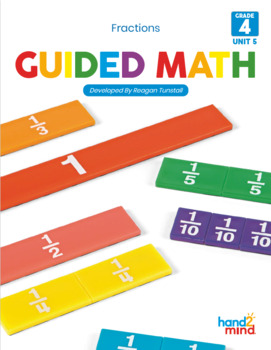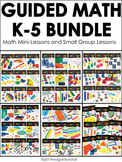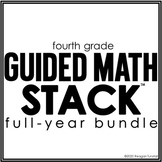Guided Math 4th Grade Fractions Unit 5
- Zip
What educators are saying
Also included in
- Guided Math Whole Group and Small Group Lessons for Fourth GradeDownload the Free Standards-Alignment for Guided MathThe entire year of math lessons aligned to standards is waiting for you. Whole group math lessons followed up with the teacher-led small group and all materials.Who Is This Designed FPrice $80.00Original Price $148.50Save $68.50
- This is a bundle of Guided Math Bundles. Each grade-level bundle contains 180 standards-aligned math mini-lessons and small group lessons with all accompanying materials. Guided Math Whole Group and Small Group Lessons Download the Free Standards-Alignment for Guided Math for each grade level WhoPrice $825.00Original Price $966.00Save $141.00
- This comprehensive STACK bundle equips teacher with all of the resources to run the guided math block!This resource is the ALL-IN-ONE Mega Bundle to run the Guided Math STACK structure in your classroom. It has all of the different bundles for the entire year for all of the components. You can alsoPrice $185.00Original Price $430.50Save $245.50
Description
Guided Math Whole Group and Small Group Lessons for 4th Grade
Download the Free Standards-Alignment for Guided Math
Fractions Unit Focus
The lessons focus on 4th grade fractions skills. Students will learn that fractions are like decimals and rational numbers that can be used to represent and describe wholes and parts. Students will learn that mathematical operations, such as addition and subtraction, can be applied to fractional quantities. There are several hands-on activities tied to the lessons, as well as rigorous problems, to prepare students for problem-solving.
Who Is This Designed For
This resource is for any regular ed. teacher, instructional coach, special education classroom, or math intervention time teacher. Stay organized, on track, and ready for your math instruction every day of the school year.
Included in Every Unit
Standards-alignment
Unit Pre-Assessment
Math Warm-Ups
20 Guided Math Lessons, including Whole Group and Teacher-Led Small Group
Materials for All Lessons
End of Unit Assessment
Bonus Materials Included
Spanish Supplement for every unit (all student materials have been translated).
Every Lesson Contains
Essential Question
Lesson Objective
Whole Group Math Mini-Lesson
Guiding Discussion Questions
Teacher-Led Small Group Lesson
General differentiation for remediation, on-level, and enrichment
Teaching materials
Student materials
Units offered for 4th Grade
Unit 1 Place Value
Unit 2 Multiplication and Division- Models and Algorithms
Unit 3 Multiplication and Division- Strategies and Problem Solving
Unit 4 Decimals
Unit 5 Fractions
Unit 6 Measurement
Unit 7 Geometry
Unit 8 Data, Graphs, Personal Finance
Unit 9 Spiral Review
All 9 Units Cover the fourth-grade Common Core Math Standards and Texas Teks. Find the free alignment here.
Hundreds of schools and districts use Guided Math for their main or supplemental math curriculum. Information about Guided Math for schools and districts here.
For Guided Math Professional Development, inquire here.
Purchasing for a school or district? We offer direct invoicing email reagan.tunstall@gmail.com
4th Grade Student Workstations that Pair with Guided Math
Math Journals for the Year
Stations by Standard Math Workstations for the Year
Skill Pages for the Year
Math Warm-Ups for the Year
Keep Informed on your favorite socials by following
Tunstall's Teaching Tidbits Website
Thank You,
Reagan Tunstall
Tunstall's Teaching Tidbits
Related Products
• Brain Train Math Dominoes Fourth Grade
• Digital ELA Warm-Ups Fourth Grade
• Digital End of Year Math Review Fourth Grade
• Digital Math Warm-Ups Fourth Grade
• Fourth Grade Bundle Place Value
• Fourth Grade Bundle Spiral Review
• Fourth Grade Digital ELA Warm-Ups FREEBIE
• Fourth Grade Exit Tickets Bundle
• Fourth Grade Exit Tickets Place Value
• The Lit Kit Fourth Grade Bundle
• Stations by Standard Place Value Fourth Grade
• Stations by Standard Bundle Fourth Grade
• Math Word Wall Cards Fourth Grade
• Home Connection Fourth Grade Guided Math
• Guided Math Fourth Grade Standards Overview
• Guided Math Fourth Grade Spine Labels
• Guided Math Assessments Fourth Grade
• Fourth Grade Skill Pages Place Value
• Fourth Grade Skill Pages Bundle
• Fourth Grade Math Chats Place Value
• Fourth Grade Math Chats Bundle
• Fourth Grade Guided Math STACK bundle
• Fourth Grade Guided Math Bundle








